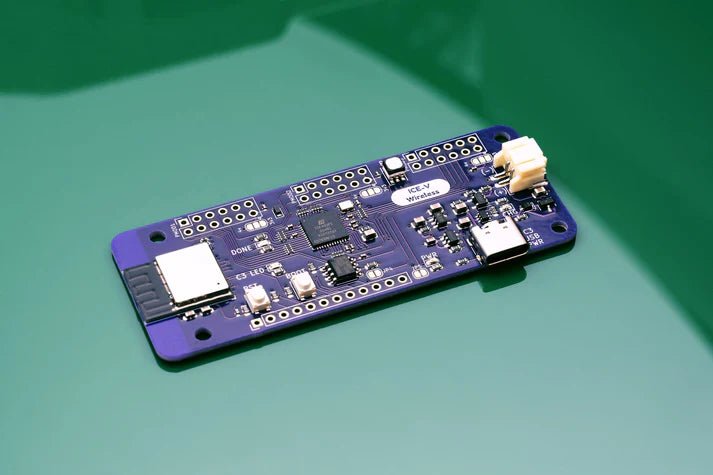
Product Feature: ICE-V Wireless
ICE-V Wireless is an ICE40UP5K+ESP32-C3 development board, allowing for the addition of WiFi and Bluetooth functionality to the FPGA by combining an Espressif ESP32C3HN4 SoC with a Lattice iCE40 FPGA.
A development board, if you aren’t familiar with the term, is a circuit board with a microcontroller (or a microprocessor) that is designed to help users acquaint themselves with programming that processor and help test new projects.
FPGA stands for Field Programmable Gate Array, and if that term confuses you at all, well, same. An FPGA is typically a little more expensive than your average microcontroller. What I like about FPGAs is that they can be shape-shfiters; because they don’t have a fixed architecture, an FPGA can be programmed to emulate a variety of architectures.
On top of that, FPGAs come with clock synchronization and asynchronous execution. This allows you to run separate chips at the same time while having them perfectly synchronized. Something interesting about this FPGA board, and most FPGAs in the ICE40 family, is that it has low static power, which makes it great for battery operated projects.

ICE-V Wireless Features:
- FPGA – Lattice Semi ICE40UP5K-SG48 FPGA with 5280 LUTs, 120 Kbits EBR RAM, 1024 Kbits PSRAM
- External RAM – 8MB PSRAM
- Wireless – ESP32-C3-MINI-1 module with 2.4 GHz WiFi 4 and Bluetooth LE through ESP32-C3 RISC-V processor, 4MB flash.
- USB – 1x USB Type-C port for power, programming, and JTAG debugging of the ESP32-C3 module
- Expansions
- 3x PMOD connectors connected to the FPGA
- I/O connector with 7x ESP32-C3 GPIO lines (serial, ADC, I2C) and one FPGA line, plus power, ground, and reset.
- 5V via USB-C port
- LiPo power/charger
- Misc – RGB LED, Reset and Boot buttons, various LEDs for power, charging, etc…

So why use the ICE-V? Don’t get me wrong, there are a lot of options out there, but when I say the ICE-V can do just about anything, I mean it. You can use it to program an FPGA, but that’s just the beginning. You can use it to emulate other processors, which opens all sorts of doors, application wise.
Are you into retro games? You can have the ICE-V Wireless pretend to be a retro gaming console and play your way into a sense of nostalgia. If that’s not your cup of tea, you can also use it to delve into neural network machine learning (called deep learning).
The PMOD 12-pin connectors provide GPIO (general purpose inputs and outputs) that allow you to communicate with sensors, other MCUs, or other electronics hardware. The ICE-V is perfect for your DIY projects, as you can use it as a one-off device to solve a problem, or just to make something fun.
The video above is the interview GroupGets conducted with the creators of the ICE-V Wireless, Eric Brombaugh and Michael Welling. They talk briefly about their backgrounds in the field before discussing the ICE-V, and how it came to be.
“I started looking at Michael’s Discord and he had stuff on there with RISC-V,” said Brombaugh. “I tried a little board based on RISC-V (from Espressif), and so the next thing to try was to integrate it with an FPGA…we started to kick the idea around on Discord and got feedback for it to be wireless. We started brainstorming the idea of having a wireless, ESP32 part, battery, FPGA, and making it super accessible with a general purpose IO.”
There’s a great article on the ICE-V Wireless by Tom Verbeure located here that goes in depth into the boot process, preloading the PSRAM with User Data, configuring wifi, and more. I’m not nearly techy enough to go into the same detail as Tom. The ICE-V Wireless is an amazing addition to most any project due to its versatile and flexible nature. It's available on GroupGets for $99.00, and our engineer Griffin custom designed a fancy case for the ICE-V which you can find here for $26.99.
